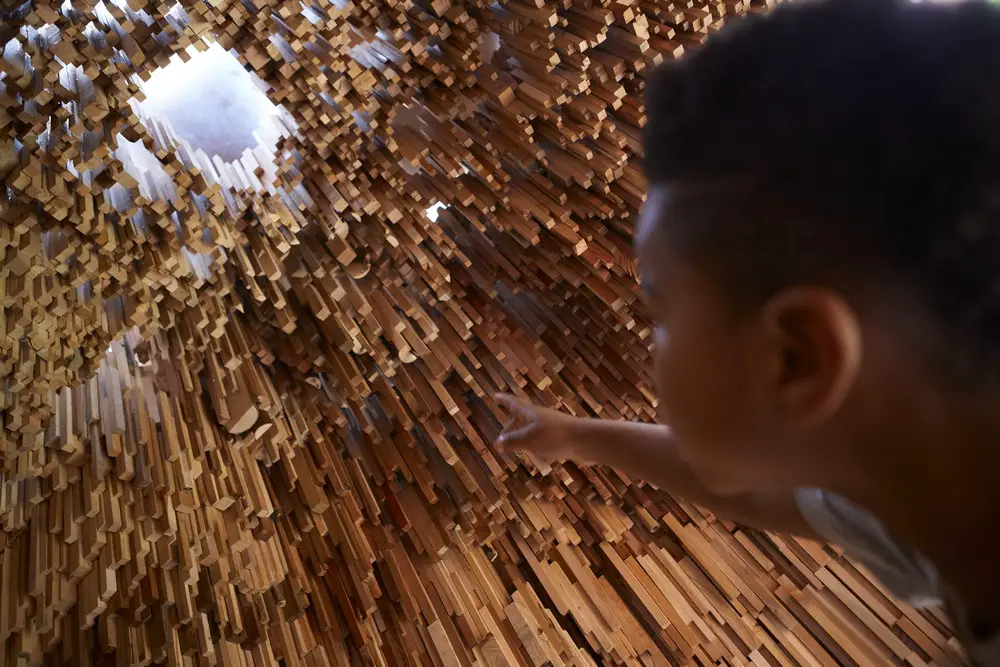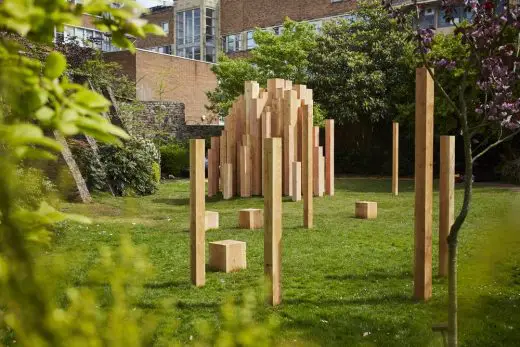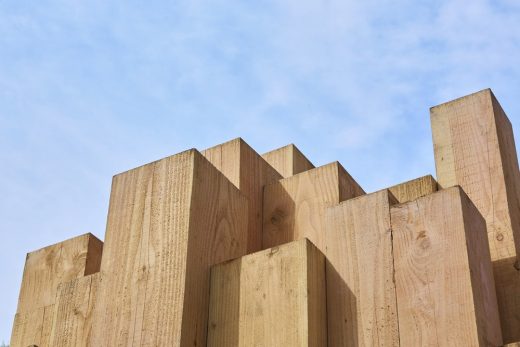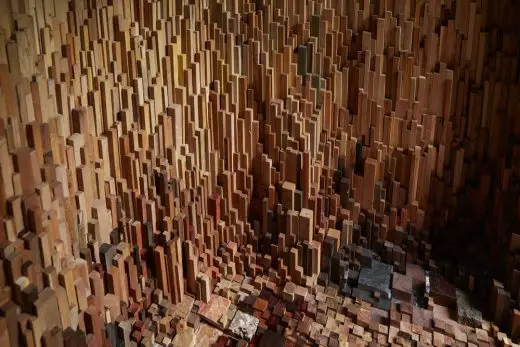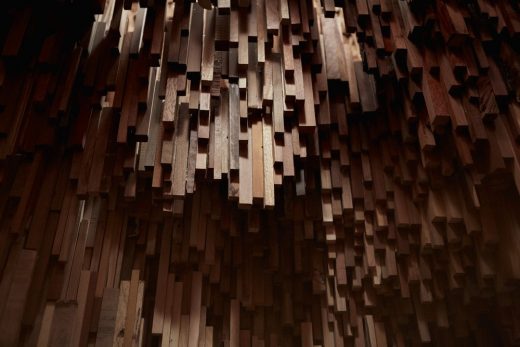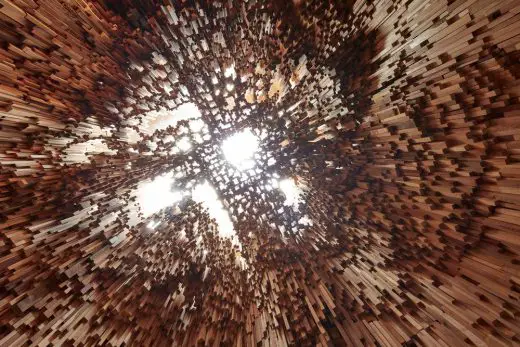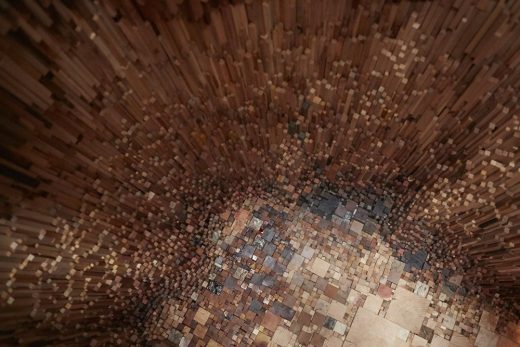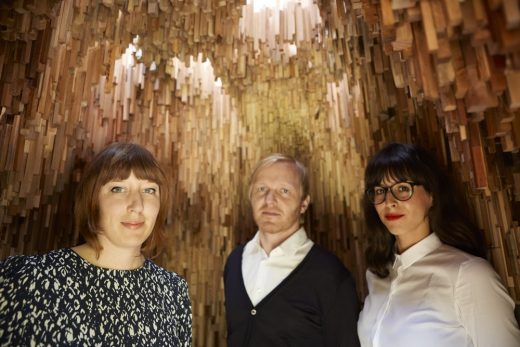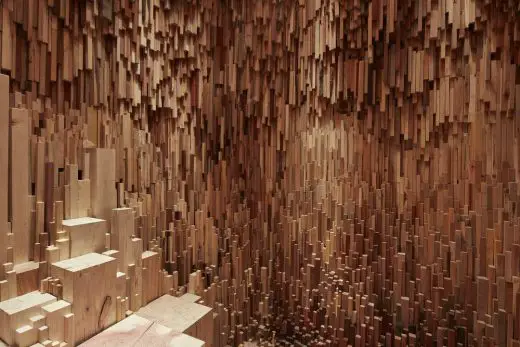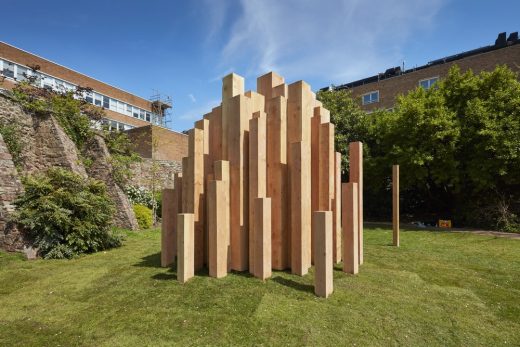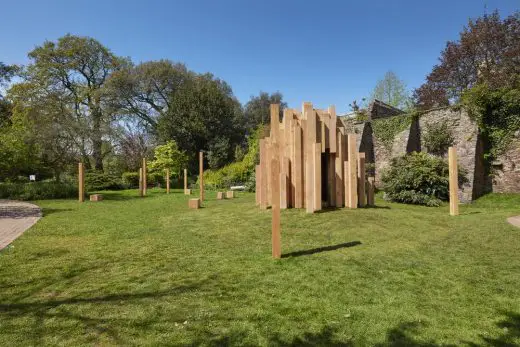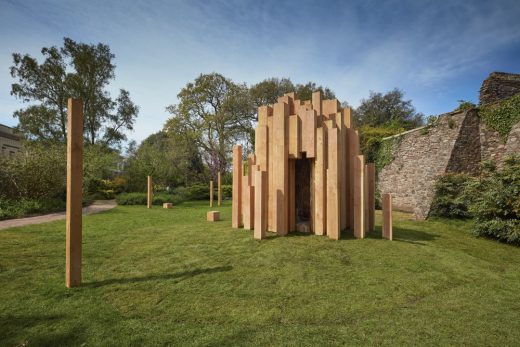Hollow, Royal Fort Gardens, UK Timber Structure, English Sculptural Architecture Images
Hollow in Bristol Public Sculpture
Public Sculpture Artwork England design by Katie Paterson and Zeller & Moye, UK
28 Jul 2016
Hollow, Bristol
Hollow in Bristol Shortlisted for Wood Awards 2016
Twenty outstanding buildings have been selected for the Wood Awards 2016 shortlist, featuring some of Britain’s best architectural designs in wood.
On the grounds of the Royal Fort Gardens in Bristol, artist Katie Paterson and architects Zeller & Moye have created a participatory, public artwork that relays stories of the planet’s history and evolution.
Hollow is a meditative space made up of over 10,000 unique tree species whose narratives span millions of years — from petrified wood fossils from the earliest forests that emerged 390 million years ago, to emergent categories of arboreal life.
The species were collected sustainably over three years from wide networks across the globe including Xylariums, Herbariums, Botanical Gardens, institutes and private wood collectors.
The Douglas fir posts that form the façade reflect varying heights of trees within a forest canopy. Once inside the warm miniature forest, visitors experience a monumental collection of tree specimens surrounding them. Above, light filters through apertures in the ceiling, mimicking the way sunlight radiates through a forest.
From Kyoto to California, the samples narrate stories from across the earth including the Indian Banyan tree, under which the Buddha achieved enlightenment, and the Japanese ginkgo tree in Hiroshima, which survived one of the darkest moments of human history.
The Wood Awards 2016 shortlist will be showcased at 100% Design on 21-24 Sep at London Olympia.
Wood Awards 2016 winners will be revealed at the 45th annual Wood Awards ceremony at Carpenters’ Hall on 22 Nov.
Location: Bristol
Architect: Zeller & Moye
Artist: Katie Paterson
Client/Owner: The University of Bristol
Structural Engineer: Momentum Engineering
Main Contractor & Joinery: Millimetre
Wood Supplier: Wenban Smith
Producers: Situation
Wood Species: Various
Hollow in Bristol information from Wood Awards
Hollow in Bristol shortlisted for Wood Awards 2016
10 May 2016
Concorde Home & Heritage Museum
Design: Katie Paterson and Zeller & Moye
Location: Bristol, England
10,000 trees span the history of the planet in new public artwork
The University of Bristol has unveiled a new public artwork by artist Katie Paterson and architects Zeller & Moye. Entitled Hollow, the artwork will be permanently sited in the historic Royal Fort Gardens in Bristol. The launch of the artwork is marked by the release of a companion digital website and public participation project, Treebank, in association with BBC Four.
The artwork has been commissioned to mark the opening of the University’s new Life Sciences building in the vicinity of the gardens and is produced by Bristol-based arts producers, Situations. The result of three years’ research and sourcing, the collection of tree species (one of the largest amassed in the UK to date) has been built through the generosity of arboretums, xylaria, herbaria and collectors world-wide.
Over 10,000 unique tree species have been gathered from across the planet, from Yakushima, Japan to the White Mountains of California, with generous donations from the Herbario Nacional de México, Royal Botanic Gardens, Kew, Kyoto University, the Arnold Arboretum at Harvard and many more.
Katie Paterson recalls: “Some samples are incredibly rare – fossils of unfathomable age, and fantastical trees such as Cedar of Lebanon, the Phoenix Palm, and the Methuselah tree thought to be one of the oldest trees in the World at 4,847 years of age, as well as a railroad tie taken from the Panama Canal Railway, which claimed the lives of between 5,000 to 10,000 workers over its 50 year construction and wood is salvaged from the remnants of the iconic Atlantic city boardwalk devastated by hurricane Sandy in 2012.”
The samples of wood span time and space and have been sourced from across the globe. From the oldest tree in the world to some of the youngest and near-extinct species, the tree samples contain within them stories of the planet’s history and evolution through time. From the Indian Banyan Tree, under which Buddha achieved enlightenment, to the Japanese Ginkgo tree in Hiroshima, a tree that witnessed and survived one of the darkest moments of human history.
Spanning millions of years, Hollow is a miniature forest of all the world’s forests, telling the history of the planet through the immensity of tree specimens in microcosm. The exterior cluster structure reflects a forest canopy’s ecosystem, the forms of the Douglas Fir posts reflecting the varying heights of trees. The interior of Hollow tells the history of the planet through over 10,000 unique tree species, from petrified wood fossils of the earliest forests that emerged 390 million years ago to the most recent emergent species.
Architects Christoph Zeller and Ingrid Moye recall: “The hollow interior is an introverted and meditative space where, whether sitting or standing, one finds oneself embraced by history. Our design conjoins thousands of wooden blocks of differing sizes to form one immense cosmos of wood producing textures, apertures and stalactites. Openings in the vaulted top let in just enough natural light to create the dappled light effect of a forest canopy.”
Professor Guy Orpen, Deputy Vice-Chancellor of the University of Bristol and Chair of its Public Arts Committee, said: “We’re very excited to see Hollow in situ at Royal Fort Gardens – it’s quite amazing to think that trees of all ages, from so many different families and from all corners of the earth, will be represented.
“It’s certainly a captivating way to celebrate the important work taking place in our world-leading Life Sciences building, where our researchers are studying many of the acute challenges which face humanity this century – such as food security, biodiversity loss and climate change. Hollow allows us to connect in new and previously unimagined ways with the beauty, complexity and depth of the natural world.”
Alongside Hollow, Situations has developed a public participation project in association with BBC Four, called Treebank. This new digital platform offers everyone the chance to contribute to a online archive of memories, impressions and creative responses which capture how trees shape our existence on the planet. These might include audio or visual contributions, describing a particular place and time, a rare and ancient tree or a common, but personally significant tree to create a digital forest for the future.
The creation of Hollow has been filmed for BBC Four’s What Do Artists Do All Day? Series, available on BBC iPlayer until the 5 June.
Photography: Courtesy of University of Bristol and Situations, Photo: Max McClure
Hollow in Bristol images / information received 100516
Location: Royal Fort Gardens, Bristol, England, UK
Bristol Architecture
Bristol Architecture Design – chronological list
Arnolfini Icon
Design: 51N4E
Bristol Icon Building
House of Fraser store, Cabot Circus
Design: Stanton Williams
Bristol House of Fraser
Bristol Metropolitan College
Design: Wilkinson Eyre Architects
Bristol Metropolitan College
Comments / photos for the Hollow in Bristol design by Katie Paterson and Zeller & Moye page welcome

